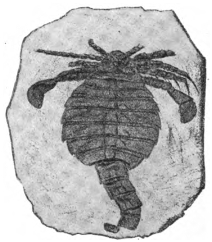Paleobiota
Arthropods
| Arthropods | |||
|---|---|---|---|
| Species | Notes | Images | |
| Slimonia acuminata | A slimonid eurypterid. |  | |
| Erettopterus bilobus | A pterygotid eurypterid. |  | |
| Pterygotus lanarkensis | A pterygotid eurypterid. | ||
| Carcinosoma scorpioides | A carcinosomatid eurypterid. |  | |
| Eusarcana obesus | A carcinosomatid eurypterid. |  | |
| ? Nanahughmilleria lanceolata | An adelophthalmid eurypterid. | ||
| ? Parastylonurus sigmoidalis | A parastylonurid eurypterid. | ||
Chordates
| Chordates | |||
|---|---|---|---|
| Species | Notes | Images | |
| Loganellia scotica | A loganelliid thelodont. |  | |
| Birkenia elegans | An birkeniid anaspid. |  | |